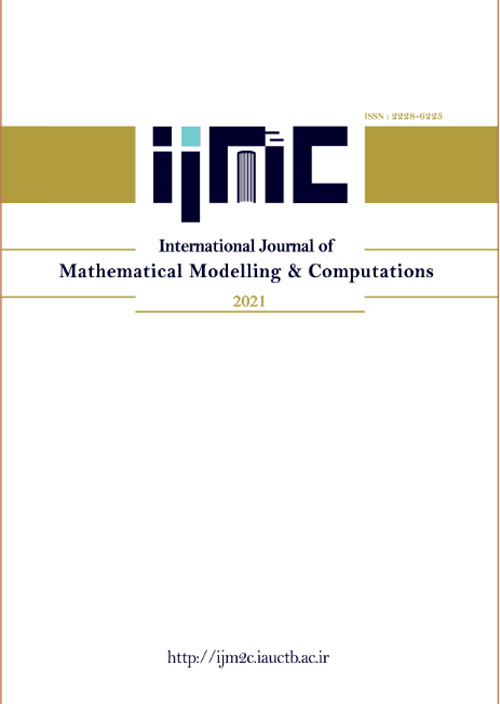فهرست مطالب

مجله بین المللی محاسبات و مدل سازی ریاضی
سال دهم شماره 4 (Autumn 2020)
- تاریخ انتشار: 1400/04/22
- تعداد عناوین: 6
-
-
Pages 265-279
In this paper, we introduce a new extension of generalized Laguerre polynomialsof two variable by using the extended Beta function. Some properties of theseextension polynomials such as generating functions, integral representation, recurrencerelations and summation formulae are obtained.
Keywords: Beta function, generalized Laguerre polynomials, generating functions, summation formulae -
Pages 281-294
In this paper, a new method for calculating the numerical approximation of the nonlinear Urysohn integral equations is proposed based on Haar wavelets. Also, the convergence analysis and numerical stability of these method are discussed. Conducting numerical experiments confirm the theoretical results of the applied method and endorse the accuracy of the method.
Keywords: Integral equations, Haar wavelet, Lipschitz condition, Successive approximations -
Pages 295-309
The nonlinear conjugate gradient method solves issues of the frame: minimizef(▁x),▁x∈R employing an iterative plot, ▁x^((k+1))=▁x^((k))+α_k ▁d^((k)), where f is a non-polynomial function.We utilized two variants of the optimum line search namely, direct and indirect methods, to compute the step-length in this paper. Both line searches yielded a great outcome when employed to a few unconstrained non-polynomial test functions.
Keywords: Nonlinear conjugate gradient method, step-length, line search, unconstrained optimization problem, large scale problems -
Pages 311-332
Onchocerciasis, usually referred to as river blindness, a skin and eye parasitic infestation is caused by the filarial nematode Onchocerca volvulus. Current control and eradication efforts are being frustrated by the continued existence and thriving of blackflies which are the disease transmitting vectors that breed along the banks of fast flowing and highly oxygenated rivers and streams. This study aims at assessing the effect of using vector traps on the transmission and control of onchocerciasis. A host-vector deterministic model which incorporates vector trapping by use of a system of ordinary differential equations is developed. The model is analysed for steady states and the basic reproduction number is obtained using the next generation method. It is found that the disease free steady state is stable if the basic reproduction number R0 < 1. There exists a unique endemic equilibrium which is locally and globally asymptotically stable if R0 > 1. Numerical simulations show that trapping the blackfly vectors has an effect on the spread and control of the disease. However, it is discovered that using traps alone is not a sufficient strategy and needs to be combined with other methods if the disease is to be completely wiped out of the population.
Keywords: Basic reproduction number, endemic equilibrium, river blindness, Sensitivity analysis, Vector Control -
Pages 333-360
In the current study, a deterministic mathematical model of HIV and Cholera co-infection is developed to analyze the impact of treatments in the presence of diseases in the population. The model consists of nine classes of the human population and one class of bacteria population. The formulated model is mathematically well-posed and biologically meaningful. The reproduction number is employed to analyze the extinction or spreading of the disease in the population. it is observed that cholera has a positive impact on HIV patients and HIV also has a positive impact on cholera patients. A separate analysis of each infection model and co-infection model is presented. Further, the stability analysis of equilibrium points is included. Finally, numerical simulations are performed using Matlab software. The result of numerical simulations shows that early treatment is very powerful for clearing or controlling cholera within a specified period of time and supports HIV/AIDS patients to live more years.
Keywords: well-posedness, Basic reproduction number, Stability Analysis, Co-infection, and Sensitivity Analysis -
Pages 361-383
In this paper, a nonlinear deterministic mathematical model of ordinary differential equations has been formulated to describe the transmission dynamics of HSV-II. The well-posedness of the formulated model equations was proved and the equilibrium points of the model have been identified. In addition, the basic reproduction number that governs the disease transmission was obtained from the largest eigenvalue of the next-generation matrix. Both local and global stability of the disease-free equilibrium and endemic equilibrium point of the model equation was established using the basic reproduction number. The results show that, if the basic reproduction is less than one then the solution converges to the disease-free steady-state and the disease-free equilibrium is locally asymptotically stable. On the other hand, if the basic reproduction number is greater than one the solution converges to endemic equilibrium point and the endemic equilibrium is locally asymptotically stable. Also, sensitivity analysis of the model equation was performed on the key parameters to find out their relative significance and potential impact on the transmission dynamics of HSV-II. Finally, numerical simulations of the model equations are carried out using the software DE Discover 2.6.4 and MATLAB R2015b with ODE45 solver. The results of simulation show that treatment minimizes the risk of HSV-II transmission from the community and the stability of disease-free equilibrium is achievable when R_0
Keywords: HSV, reproductive number, Stability Analysis, Sensitivity

